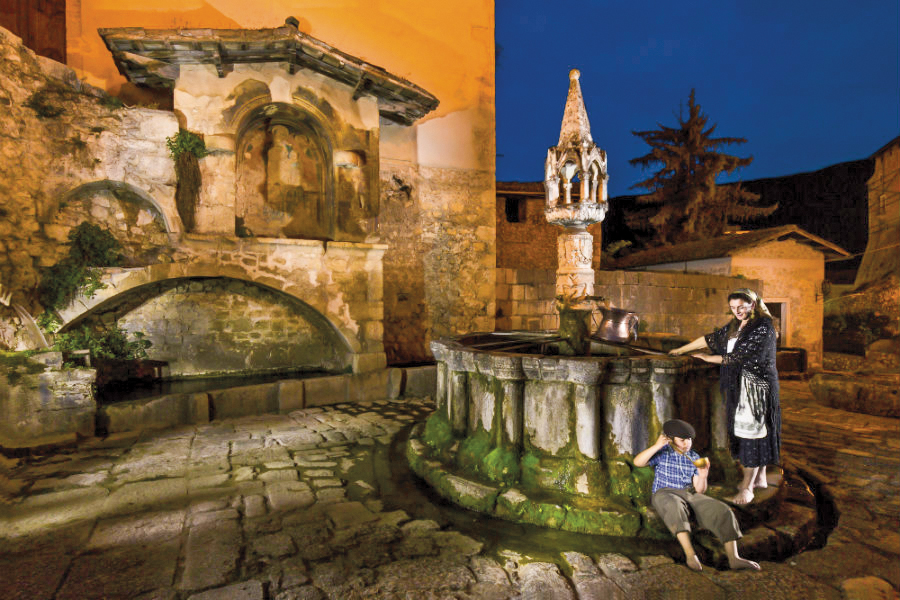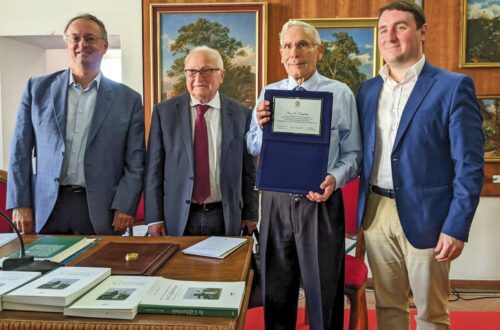
Fontecchio

By Nancy DeSanti

Credit: Giorgio Marcoaldi
Province of L’Aquila, Region of Abruzzo
The small medieval town of Fontecchio is located in the province of L’Aquila within the Monte Sirente community and the Sirente-Velino Regional Park. It has approximately 401 inhabitants, known as Fontecchiani or Fonticulani.
There is archaeological evidence of the Roman settlement of Fonticulanum down on the Aterno River. In the Middle Ages, a castle was built on top of the hill and the population moved up there.
Today, visitors can see a wonderful and well-preserved historical center. At the sites called Il Castellone and Monte San Pio, pre-Roman constructions were found, and inside the town itself there are Roman remains. The medieval settlement arose in the 11th century from the union of five hamlets (vici), including Fons Tichiae. In 1648, the town was besieged and destroyed during a period of 50 days.
Fontecchio’s historic center preserves the characteristic of a fortified medieval village, with access doors, sections of high walls, towers and majestic palaces, among which stands the mighty fortified palace of the Barons Corvi, from which, according to an ancient tradition, the Marquise Corvi put an end to the long siege by the army of Braccio da Montone by killing the leaders of the assailants with a sledgehammer.
To commemorate the siege, every evening the Clock Tower (Torre dell’Orologio) beats 50 times, as many as the days of the siege, thus mixing history, legend and tradition. The clock, considered one of the oldest in Italy, moves the single hand based on a perfect mechanism of weightsand beats the “Italian hours,” that is, the dial is divided into six hours and the mechanism moves only the hour hand.
Among the many, still very visible, Roman architectural remains are the base of a temple dedicated to Jupiter where the Church of Santa Maria della Vittoria was built. The brick flooring is arranged in a herringbone fashion behind the apse of the church.
Fontecchio was severely damaged by an earthquake in L’Aquila in 1703, and later also from the L’Aquila earthquake of 2009. After the major earthquake in 2009,half of the town’s homes were condemned as unsafe. The tower hosts a permanent photographic exhibition on the places in L’Aquila before and after the 2009 earthquake.
Today, though, Fontecchio is buzzing with construction and activity, and has become a hub for international artists.
What to See
- Clock Tower
- Fonte Trecentesca
- Convent of San Francesco
- Church of Santa Maria della Pace
- Church of Madonna delle Grazie
- Church of Santa Maria della Vittoria
- The Piazza del Popolo with an artistic, unique 14th-century fountain
- Church of St. Francis with a fine Romanesque portal
Important Dates
- February 3 – Feast of St. Blaise, the patron saint
- Summer – “Paese in Arte” Festival, featuring several cultural events.
Italiano
Fontecchio

Tradotto da Ennio Di Tullio

Credit: Wikipedia
Provincia di L’Aquila, Regione Abruzzo
Il piccolo borgo medievale di Fontecchio si trova in provincia dell’Aquila all’interno della comunità del Monte Sirente e del Parco Regionale Sirente-Velino. Conta circa 401 abitanti, detti Fontecchiani o Fonticulani.
Esistono testimonianze archeologiche dell’insediamento romano di Fonticulanum sul fiume Aterno. In epoca medioevale venne costruito un castello sulla sommità del colle e la popolazione vi si trasferì.
Oggi i visitatori possono vedere un centro storico meraviglioso e ben conservato. Nei siti denominati Il Castellone e Monte San Pio sono state rinvenute costruzioni preromane e all’interno del paese stesso sono presenti resti romani. L’insediamento medievale sorse nell’XI secolo dall’unione di cinque frazioni (vici), tra cui Fons Tichiae. Nel 1648 la città fu assediata e distrutta per un periodo di 50 giorni.
Il suo centro storico conserva la caratteristica di borgo medievale fortificato, con porte di accesso, tratti di alte mura, torri e palazzi maestosi, tra i quali spicca il poderoso palazzo fortificato dei Baroni Corvi, da cui, secondo un’antica tradizione, la Marchesa Corvi pose fine al lungo assedio dell’esercito di Braccio da Montone, uccidendo con una mazza i capi degli assalitori.
Per commemorare l’assedio, ogni sera la Torre dell’Orologio (Torre dell’Orologio) batte 50 volte, tanti quanti i giorni dell’assedio, mescolando così storia, leggenda e tradizione. L’orologio, considerato uno dei più antichi d’Italia, muove la sola lancetta basata su un perfetto meccanismo di pesi e batte le “ore italiane”, cioè il quadrante è diviso in sei ore e il meccanismo muove solo la lancetta delle ore.
Tra i tanti resti architettonici romani ancora ben visibili vi è il basamento di un tempio dedicato a Giove dove fu edificata la Chiesa di Santa Maria della Vittoria. Il pavimento in laterizio è disposto a spina di pesce dietro l’abside della chiesa.
Fontecchio è stata gravemente danneggiata dal terremoto dell’Aquila nel 1703, e successivamente anche dal terremoto dell’Aquila del 2009. Dopo il forte terremoto del 2009, metà delle abitazioni del paese sono state condannate come pericolanti. La torre ospita una mostra fotografica permanente sui luoghi dell’Aquila prima e dopo il terremoto del 2009.
Oggi, però, Fontecchio brulica di costruzioni e attività, ed è diventata un hub per artisti internazionali.
Le attrazioni del luogo:
- Torre dell’orologio
- Fonte Trecentesca
- Convento di San Francesco
- Chiesa di Santa Maria della Pace
- Chiesa della Madonna delle Grazie
- Chiesa di Santa Maria della Vittoria
- La Piazza del Popolo con una fontana artistica e unica del 14° secolo
- Chiesa di San Francesco con bel portale romanico
Date da ricordare:
- Febbraio – Festa di San Biagio, patrono
- Estate – Festival “Paese in Arte”, caratterizzato da numerosi eventi culturali.
| Sources: |
| https://en.wikipedia.org/wiki/Fontecchio https://www.italyheritage.com/regions/abruzzo/laquila/fontecchio.htm https://www.e-borghi.com/en/village/L’Aquila/328/fontecchio |
Issue Date





